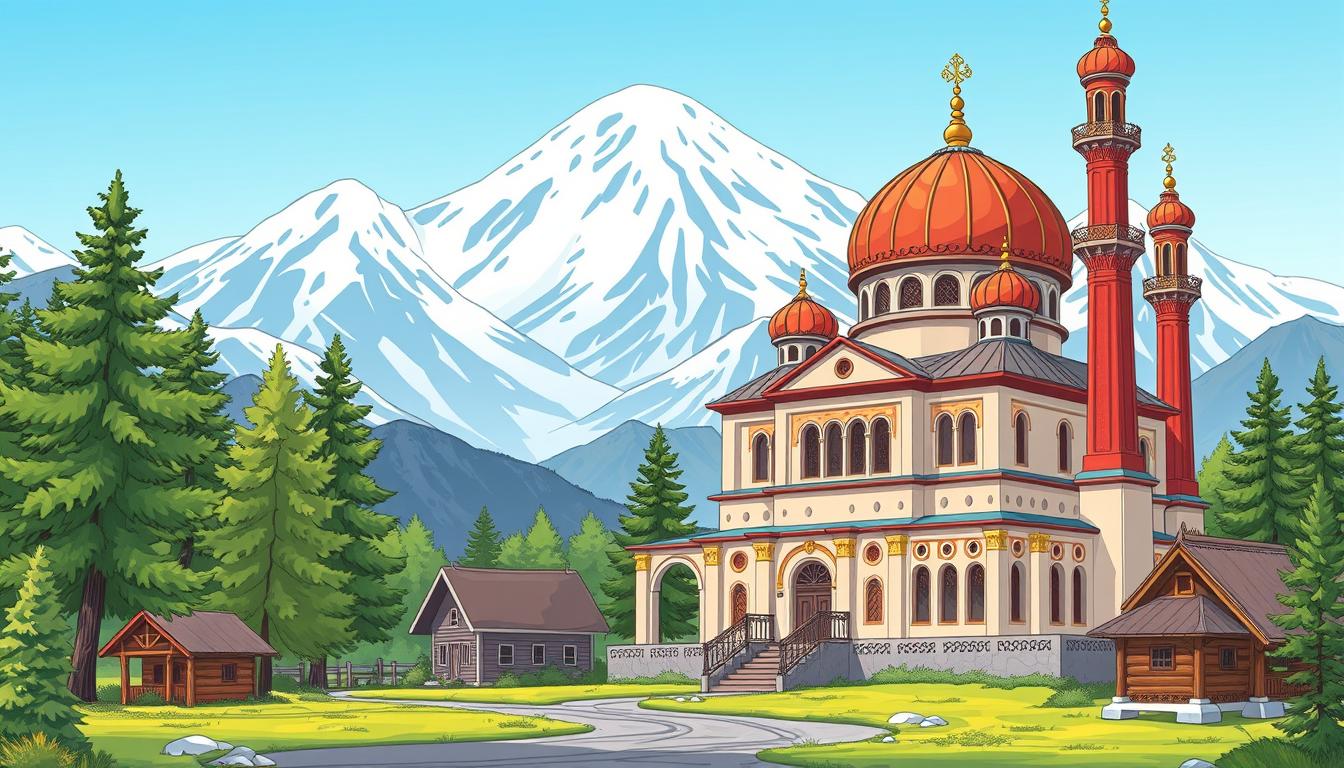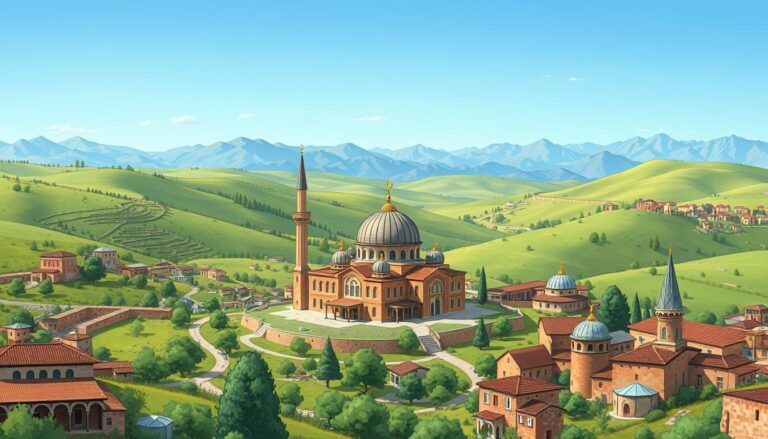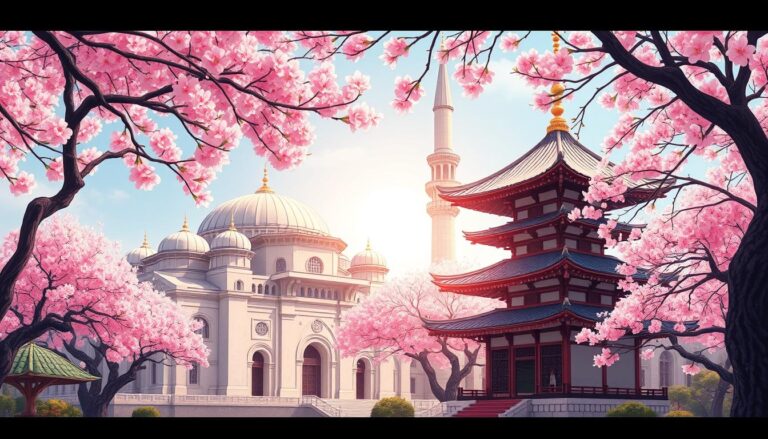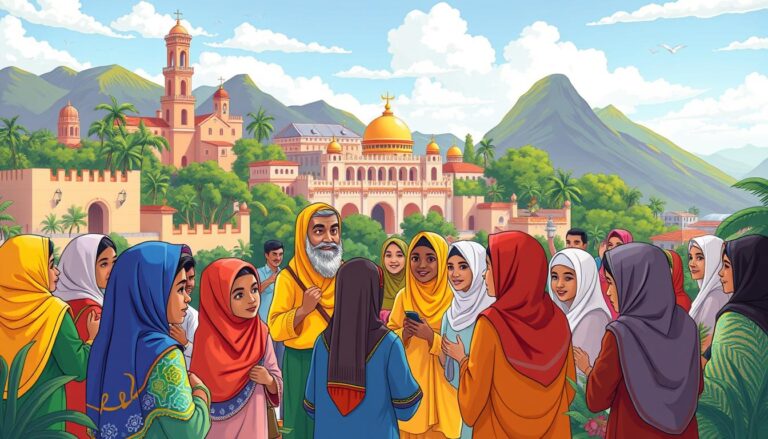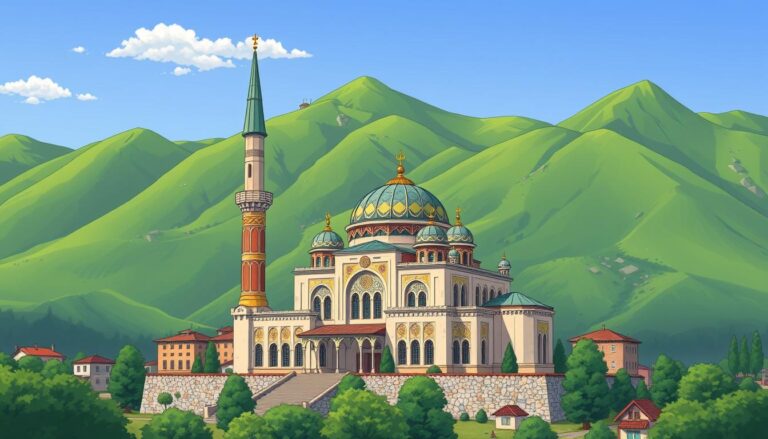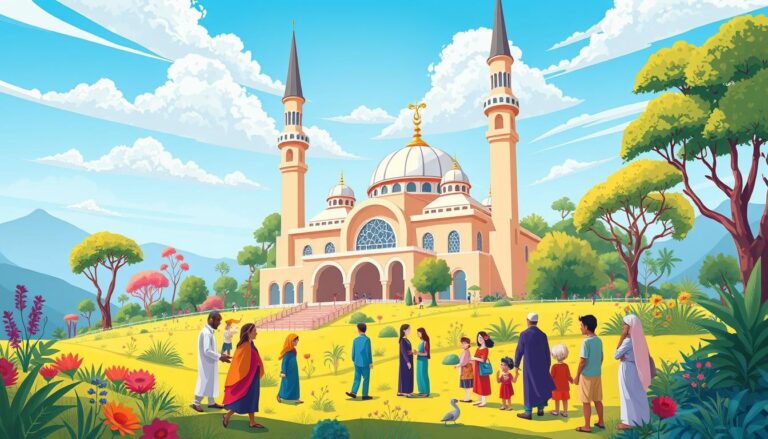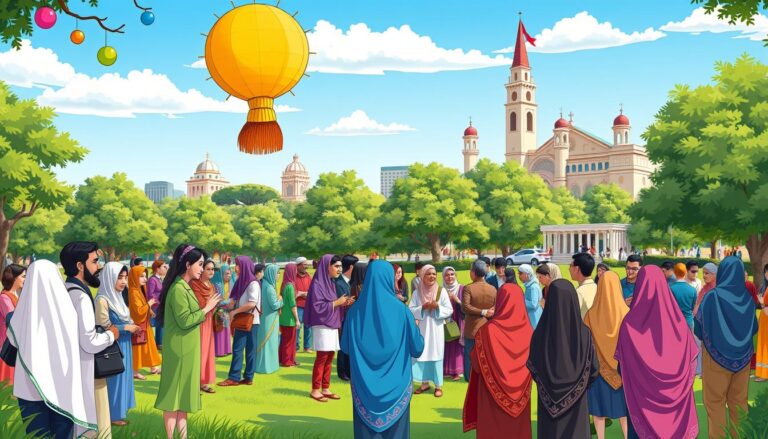Islam in Russia
According to the US Department of State in 2017, Muslims in Russia numbered 14 million or roughly 10% of the total population. One of the Grand Muftis of Russia, sheikh Rawil Gaynetdin, estimated the Muslim population of Russia at 25 million in 2018. Islam is recognized under the law and by Russian political leaders as one of Russia’s traditional religions, and is subsidized by the Russian government. The history of Islam in Russia encompasses periods of conflict between the Muslim minority and the Orthodox majority, as well as periods of collaboration and mutual support.
Key Takeaways
- The Muslim population in Russia has grown significantly, reaching an estimated 25 million people or more.
- Islam is recognized as one of Russia’s traditional religions and is supported by the government.
- The relationship between Muslims and the Orthodox majority in Russia has been complex, with both periods of conflict and collaboration.
- Russian Muslims come from diverse ethnic and cultural backgrounds, with Sunnis of the Hanafi school being the majority.
- The Russian government has employed various strategies to manage and co-opt the Muslim population, including centralization of power and delegating authority to Muslim-majority regions.
Historical Overview of Islam in Russia
The introduction of Islam to the Russian lands dates back to the mid-7th century AD, when the religion first reached the Caucasus region as part of the Muslim conquest of Persia. The Dagestani people were among the first to convert to Islam following the Arab conquest of the region in the 8th century.
One of the earliest Muslim states established within the future Russian territories was Volga Bulgaria, formed in 922 AD. The Tatars of the Khanate of Kazan later inherited the population of believers from this state. Over time, many of the European and Caucasian Turkic peoples also embraced Islam.
Muslim Peoples and States of Pre-Imperial Russia
The Mongol rulers of the Golden Horde became Muslim in 1313, and by the 1330s, three of the four major khanates of the Mongol Empire had converted to the faith. The Tatars of the Crimean Khanate, the last remaining successor to the Golden Horde, continued to raid Southern Russia and even burned down parts of Moscow in 1571.
“There were more than 30 indigenous Russian nations represented at the conference discussing Islamic identity in Russia.”
The introduction of Islam to the Russian lands has played a significant role in shaping the religious and cultural landscape of the region, with the Volga Bulgars, Crimean Tatars, and other Muslim peoples leaving a lasting impact on the history of the country.
Muslims under the Russian Empire
The period from the Russian conquest of Kazan in 1552 by Ivan the Terrible to the ascension of Catherine the Great in 1762 featured systematic Russian repression of Muslims through policies of exclusion and discrimination, as well as the destruction of Muslim culture by the elimination of outward manifestations of Islam such as mosques. However, the Russians initially demonstrated a willingness in allowing Islam to flourish as Muslim clerics were invited into the various regions to preach to the Muslims, particularly the Kazakhs.
Tsarist Policies Towards Islam
Over time, Russian policy shifted toward weakening Islam by introducing pre-Islamic elements of collective consciousness. Despite this, many Muslims in the Russian Empire remained loyal to the Russian state, and some even served in the Cossack ranks and fought against Napoleon’s forces during the Napoleonic Wars.
Contributions of Muslims to the Russian Empire
- Official statistics indicate that around 1900, the Russian Empire had 14 million Muslim subjects.
- Muslim Duma representatives even claimed a higher number of Muslim subjects, around 30 million.
- The core of the Muslim population was predominantly located around Kazan, which was conquered in the 16th century by Ivan the Terrible.
- Other regions with significant Muslim populations in the Russian Empire included the Crimea, Azerbaijan, Caucasus, and Central Asia.
- From 1905 to 1917, a total of 166 Tatar newspapers and magazines were founded, indicating a vibrant Muslim newspaper milieu.
- The Russian administration started opening schools in Kazan where the Tatar language was taught for the first four years, with an emphasis on the Russian language in the curriculum.
- The Jadid reform movement aimed to modernize Muslim societies and advocated for the introduction of worldly topics in education.
- The first Muslim congress held in Russia led to the pledge to establish a Union of the Muslims of Russia, highlighting the push towards national Muslim unity.
- Jadidism, with its reform agenda, faced opposition from the traditionalist Kadimists, illustrating the diversity of opinions within the Muslim community in the Russian Empire.
“The Russian administration started opening schools in Kazan where the Tatar language was taught for the first four years, with an emphasis on the Russian language in the curriculum.”
Islam During the Soviet Era
The Soviet Union’s approach to Islam underwent a dramatic transformation following the Bolshevik Revolution. Initially, the Soviets granted Muslims more religious autonomy compared to the suppression they faced under the tsars. Lenin’s government returned Islamic artifacts and implemented some Sharia principles alongside the communist system. However, this open policy was short-lived.
By the late 1920s, the Soviet government had rejected the arguments of national communists, leading to a large-scale purge of Muslim-majority Union Republics’ leadership. This resulted in the elimination of many Muslim leaders and the active suppression of Islamic practices across the Soviet Union. By the 1970s, there were only 500 mosques across the entire Soviet Union, down from 25,000 at the time of the Bolshevik Revolution.
Early Soviet Policies on Islam
In the early Soviet era, the Bolsheviks issued an appeal to “All the Muslim Workers of Russia and the East,” recognizing the rights and autonomy of Muslim communities. They even returned Islamic artifacts like the Uthman Quran to Muslim regions and incorporated Islamic law principles alongside the communist legal system.
However, this initial openness was soon replaced by a policy of active suppression. The Soviet government began a large-scale purging of the Muslim-majority Union Republics’ leadership, leading to the elimination of many Muslim leaders and the active suppression of Islamic practices. By the 1970s, the number of operational mosques had dwindled to just 500, a significant decrease from the 25,000 mosques present in the Russian Empire in 1917.
“The Soviet regime undertook the closure and destruction of hundreds of mosques during their rule.”
Muslim Ethnic Groups in Russia
Russia is home to a diverse array of Muslim ethnic groups, each with its own rich cultural heritage and traditions. Among the most prominent are the Tatars and Bashkirs of the Volga region, as well as the Caucasian Muslims found throughout the North Caucasian Federal District.
Tatars and Bashkirs of the Volga Region
The Tatars are the second-largest ethnic group in Russia, with a strong presence in the Volga region. Tracing their roots back to the Turkic-speaking peoples of the Volga-Ural area, the Tatars have a long and storied history of Islamic influence. The majority of Tatars are Sunni Muslims, following the Hanafi school of jurisprudence.
Neighboring the Tatars are the Bashkirs, another Turkic-speaking Muslim group. The Bashkirs have a deep-rooted connection to Islam, with the vast majority identifying as Sunni Muslims. Both the Tatars and Bashkirs have played a significant role in shaping the religious and cultural landscape of the Volga region.
Caucasian Muslims
The North Caucasian Federal District is home to a diverse array of Caucasian Muslim ethnic groups, including the Circassians, Balkars, Chechens, Ingush, Kabardin, Karachay, and numerous Dagestani peoples. These communities have a rich history of Sufi Islamic traditions, with the Naqshbandi, Kadiri, and Shadhili tariqats (orders) being particularly influential.
The Caucasian Muslims have played a crucial role in shaping the cultural and religious landscape of Russia, contributing to the country’s vibrant and multifaceted Islamic heritage. Their influence extends beyond ideology, with Islamic principles and practices permeating various spheres, including legal, economic, and educational domains.
“Islam is one of Russia’s four traditional religions with longstanding presence in the country.”
The diversity of Muslim ethnic groups in Russia is a testament to the country’s rich cultural tapestry. From the Tatars and Bashkirs of the Volga region to the Caucasian Muslims of the North Caucasus, each community has left an indelible mark on the nation’s history and identity.
Mosques and Islamic Architecture in Russia
Russia is home to a diverse array of Islamic architecture, reflecting the country’s rich cultural heritage and the deep-rooted presence of the Muslim faith. Despite periods of suppression and destruction, Russia has preserved and revived numerous mosques and religious structures that stand as testaments to the nation’s Islamic legacy.
From the grand Kul Sharif Mosque in Kazan, with its six towering minarets, to the historic Jumah Mosque in Derbent, dating back to 750 AD, Russia’s mosques showcase a blend of architectural styles and cultural influences. The Moscow Cathedral Mosque, the tallest in Europe, can accommodate up to 10,000 worshippers, underscoring the significant Muslim population in the country.
Other notable Islamic structures include the Lala Tulpan Mosque in Ufa, boasting the tallest twin minarets in Russia at 53 meters, and the Heart of Chechnya Mosque, capable of housing 10,000 people simultaneously. These grand and intricate buildings not only serve as places of worship but also stand as cultural and historical landmarks, attracting visitors from around the world.
The Bolgar State Historical-Architectural Museum Reserve, a UNESCO World Heritage site, is another testament to Russia’s Islamic heritage, showcasing the remains of the ancient city of Bolgar, once the capital of the Golden Horde. The White Mosque, built in 2012, stands as a modern addition to this historic site, blending traditional and contemporary Islamic architectural elements.
As Muslims make up nearly 20% of Russia’s population, the country’s mosques and Islamic architecture hold immense significance, not only as religious centers but also as cultural and historical treasures that contribute to the rich tapestry of Russia’s diverse identity.
“Russia is believed to be home to around 25 million Muslims, with seven of its 22 republics having Muslim majorities.”
Islamic Education and Literature in Russia
Despite the Soviet era’s suppression of Islamic teachings and theology, the post-Soviet period has witnessed a gradual revival of Islamic education and scholarship in Russia. Islamic education in Russia has regained a legally recognized space, with the government subsidizing mosques and madrasas, or Islamic schools, across the country.
President Vladimir Putin has emphasized the importance of Islamic scholarship in Russia, describing it as an “integral part of Russia’s cultural code.” In recent years, efforts have been made to revive Islamic education and reinvigorate the role of madrasas in shaping the religious and cultural landscape of the nation.
“The newly established North Caucasus Federal University is expected to have nearly 40,000 students across its branches in the North Caucasus.”
The government’s strategy to collaborate with specific Muslim clerics has led to a subtle conflict between the murids (spiritual disciples) and the authorities, potentially fueling armed resistance in the future. However, the government’s perceived attempt to gain total control over the Muslim community may also trigger protests and support for separatist movements.
Despite the challenges, the revival of Islamic education and scholarship in Russia holds the potential to strengthen the country’s cultural diversity and foster a deeper understanding of the role of Islam in the Russian Federation.
Islam in Russia
Russia is not only an Orthodox Christian country but also a significant Muslim nation. With a population of over 142 million, Russia is home to more than 20 million Muslims, including members of more than 30 indigenous Russian ethnic groups. This diverse Muslim community has a rich history and a distinct tradition within the broader context of Russian society.
Ethnically, the major Muslim peoples in Russia include the Volga (Kazan) Tatars (7 million), Bashkirs (1.5 million), Chechens (1 million), Avars (600,000), Lezgins (500,000), and a significant presence of other Caucasian groups such as the Kabardins, Dargins, Kumyks, Ingush, Karachays, Adighe, Balkars, and Circassians. Islam is also professed by a portion of the Ossetian population, around 30,000 individuals.
These Muslim communities in Russia belong to various linguistic families, including Turkic, North-Eastern Caucasian, Vainakh, and Western (Adigo-Abkhazian) groups. They have maintained their traditional social structures and divisions, with distinctions between descendants of nobility, free community members, hereditary religious leaders, and other social strata.
Despite the complex history of Islam in Russia, which includes periods of both suppression and acceptance, Russian Muslim leaders today promote loyalty and cooperation with the secular Russian state. They emphasize Islam’s position as one of the traditional faiths of the Russian people, and there is a growing consensus that Russia has the potential to successfully integrate its diverse religious communities, including its Muslim population.
According to the latest data, Muslims make up approximately 15% of the total Russian population, with the Shia sect representing 3% of the Muslim population. The arrival of Islam in Russia dates back to the 7th century, and the religion has had a significant influence on the country’s history, culture, and social fabric.
As Russia continues to navigate the challenges and opportunities of its diverse religious landscape, the role and integration of the country’s Muslim communities will undoubtedly remain a topic of ongoing discourse and debate.
Russian Islam: A Distinct Tradition?
As the Russian Muslim population continues to grow, debates have emerged around the nature of “Russian Islam” and whether it represents a distinct tradition. Some experts argue that most Russian Muslims embrace a modernist, ecumenical interpretation of Islam that is compatible with the secular state. They believe the Russian government should encourage these moderate tendencies.
However, others contend that current state efforts to foster a “Russian Islam” are doomed to fail, as Muslims view such intervention as illegitimate. Nonetheless, most speakers agree that Russia’s Muslims generally reject radicalism, even as concerns remain about the lack of Islamic education and the influence of foreign missionaries.
Debates on the Nature of Russian Islam
The distinctiveness of Russian Islam has been a topic of ongoing debate. While some see Russian Muslims as embracing a modernist, ecumenical interpretation of Islam, others argue that attempts by the state to cultivate a “Russian Islam” are futile, as Muslims perceive such efforts as illegitimate.
Despite these differences, there is a broad consensus that Russian Islam is generally tolerant and rejects radicalism. However, concerns persist about the insufficient access to Islamic education and the influence of foreign missionary activities among the Muslim population.
“Most Russian Muslims are committed to the secular state and reject radicalism, though the lack of Islamic education and foreign missionary influence remain issues of concern.”
The ongoing debates on the Distinctiveness of Russian Islam highlight the complexities and nuances within the Muslim community in Russia. As the country’s Muslim population continues to evolve, understanding the diverse perspectives and addressing the challenges facing this community will be crucial for fostering social cohesion and religious harmony.
Integration of Muslims in Russian Society
Russia’s Muslim population, estimated between 16 to 20 million, is the largest in Europe. The integration of Muslims in Russian society has a unique historical model, where Muslims have lived in the country’s territory for centuries and have been active participants in the political life of the Russian Empire.
Contrary to the perception of Muslims as outsiders, most Russian Muslims feel committed to the integrity and survival of Russia. Islamic leaders work to address social problems and strengthen Russian society, promoting loyalty and cooperation with the secular state.
Surveys have revealed nuances in the political attitudes of Russia’s Muslim communities. While Muslims from the North Caucasus region tend to trust President Putin more, they also display higher levels of distrust towards institutions like the police, courts, and banks. In contrast, Muslims from other regions, primarily the Volga region, show lower levels of trust in Putin but have less institutional distrust compared to non-Muslim Russians.
These differences highlight the diversity within the Muslims in Russian society. The integration of Muslims in Russia is not a recent development, but rather a historical model of Muslims as loyal citizens and subjects of the Russian state.
“There is a historical model of Muslims as loyal citizens/subjects of a Russian state, and many examples of Muslims who were active in the political life of the Russian Empire.”
Despite concerns over the lack of Islamic teaching and the potential spread of radical Islamic ideology, most Russian Muslims exhibit tolerance and reject radicalism. The Russian government has the potential to successfully integrate its diverse religious communities, including Muslims, by promoting interfaith dialogue and addressing social issues.
Radical Islam and Separatist Movements
The activities of Muslim missionaries have fueled fears of the radicalization of Russian Muslims, and the Chechen conflict has been particularly troubling to many. However, experts argue that Chechen separatism was based more in secular nationalism rather than Islam, and that the espousal of political Islamic ideology was used as a “very convenient slogan” to rally support for the separatist movement.
Despite this, the Radical Islam and Separatist movements in Russia’s Muslim-majority regions, particularly in the North Caucasus, continue to be a concern. The collapse of the Soviet Union led to the reintroduction of Islam into public life in these regions, and growing numbers of young Russian Muslims have started identifying with co-religionists in Chechnya, Afghanistan, and Iraq.
The Chechen Conflict and Islamic Extremism
The Chechen conflict has been a particular source of tension, with the North Caucasus, including Chechnya, Ingushetia, and Dagestan, becoming a breeding ground for Islamic extremism. The region has seen a rise in terrorist activities and the influence of groups like the Islamic State, with individuals from the North Caucasus making up a significant portion of the group’s forces in Syria.
- A poll from 2019 revealed that 14.5 percent of high school students and 9 percent of teachers in Dagestan showed support for compatriots who joined ISIS.
- Digital platforms like “KavkazCenter.org” and “ChechenInfo” disseminate propaganda videos that focus on the jihadist element in the North Caucasus, resistance against the Russian Federation, and the involvement of North Caucasian fighters in the Ukraine conflict.
The Russian government has attempted to address these issues, with Ramzan Kadyrov, the leader of Chechnya, being promoted to the rank of colonel general in the Russian armed forces. However, Kadyrov’s regime ideology, which incorporates Islam to maintain “stability” in Chechnya, has raised concerns about the long-term implications for the region’s stability and the integration of Muslims in Russian society.
“Kadyrov positions himself as the spokesperson not only of the Chechens but also of the 30 million Russian Muslims.”
As Russia continues to grapple with the challenges posed by Radical Islam and Separatist movements, the future of Islam in the country remains a complex and multifaceted issue.
Government Policies and the Future of Islam in Russia
The Russian government’s approach to Islam has evolved significantly over the years. While President Vladimir Putin made some Islamophobic comments during the Second Chechen War, he has since taken steps to support the practice of Islam in the country. The government now recognizes Islam as one of Russia’s traditional religions and provides legal and financial assistance for its observance.
According to experts, a prosperous and open Russia that allows for the legitimate expression of ethnic and cultural diversity will be an attractive prospect for the country’s Muslim population. The government’s policies suggest that Russia has the potential to successfully integrate its diverse religious communities, including Muslims.
However, the integration of Muslims into Russian society has not been without its challenges. Ethnic violence against people with Muslim backgrounds accounts for 30 to 60 percent of all ethnic violence data collected in Russia, and there have been documented acts of violence against Muslim architecture, cemeteries, and prayer rooms.
Despite these issues, the future of Islam in Russia appears promising. The Muslim population is projected to represent between one-third to one-half of the Russian population by around 2050, driven by internal migration from Muslim-majority southern regions to major Russian cities. The growing presence of Islam in Russia could shape the country’s policies and social dynamics in the years to come.
“Demography is a significant driver of Russian policy in the Middle East, with potential for Islam to become the majority religion in Russia by 2050.”
- The Russian government has recognized Islam as one of the country’s traditional religions and provides legal and financial support for its practice.
- Experts believe that a prosperous and open Russia that allows for the legitimate expression of ethnic and cultural distinctiveness will be attractive to the country’s Muslim population.
- Ethnic violence against people with Muslim backgrounds is a concern, but the government appears committed to integrating its diverse religious communities.
- The Muslim population is projected to represent between one-third to one-half of the Russian population by around 2050, driven by internal migration.
As the Russian government policies on Islam continue to evolve and the future of Islam in Russia takes shape, it will be crucial to monitor the integration of the country’s Muslim communities and the impact on its social and political landscape.
Conclusion
The story of Islam in Russia is a complex and multifaceted one, marked by periods of both conflict and collaboration between the Muslim minority and the Orthodox Christian majority. From the early introduction of Islam to the Russian lands, to the experiences of Muslim peoples and states under the Russian Empire and the Soviet regime, the role of Islam in shaping Russia’s cultural and political landscape has been significant.
Today, Russia is home to a sizable Muslim population, with Muslims forming a majority in several regions and playing a vital part in the country’s cultural and social fabric. While debates continue around the nature of “Russian Islam” and concerns about radicalization persist, the Russian government has generally sought to integrate Muslims into Russian society and support the practice of Islam as one of the country’s traditional faiths.
As Russia continues to evolve and navigate the challenges of the modern era, the place of Islam in the country’s national identity will likely remain an important and dynamic aspect of its ongoing transformation. The rich history, diverse communities, and complex interactions between Islam and Russia’s socio-political landscape offer a unique and compelling perspective on the role of religion in shaping the identity of a nation straddling the divide between Europe and Asia.
Source Links
- Islam in Russia
- The Co-optation of Islam in Russia
- What the rise of Islam means for Putin’s Russia
- Islam in Russia: History, Politics and Culture
- Islam in Russia
- Islam in the Russian Empire (Chapter 10) – The Cambridge History of Russia
- Union of the Muslims of Russia
- Islam in the Soviet Union
- The Rise of Political Islam in Soviet Central Asia
- Russian Islam and the Situation in the Middle East
- Exploring Russia’s Islamic heritage
- These Mosques In The Snowy Russia Will Add A Dash Of Architecture To Your Trip!
- Moscow Cathedral Mosque
- Russian Islam or Islam in Russia?
- Muslims and Islam in Russia: A Historical Overview
- Muslims and their Organizations in Russia
- Russia and the Region’s Muslims: A History of Relations – İnsamer – İnsamer
- Russia – United States Department of State
- Analytics
- Islam in Russia
- Political and Social Attitudes of Russia’s Muslims: Caliphate, Kadyrovism, or Kasha? – PONARS Eurasia
- Discourse on Identity, Politics, and Security
- When It Comes to Political Islam, Moscow Seems Confused
- Leveraging Islam and Internal Conflict
- IntelBrief: Radicalization and Extremism in Russia’s North Caucasus Region – The Soufan Center
- Microsoft Word – Laruelle FINAL.docx
- ISLAM IN RUSSIA: PAST, PRESENT AND FUTURE
- How Muslim communities’ growth is shaping Russia’s future
- The Dynamics of Russian Islam
- Russia and Islam

